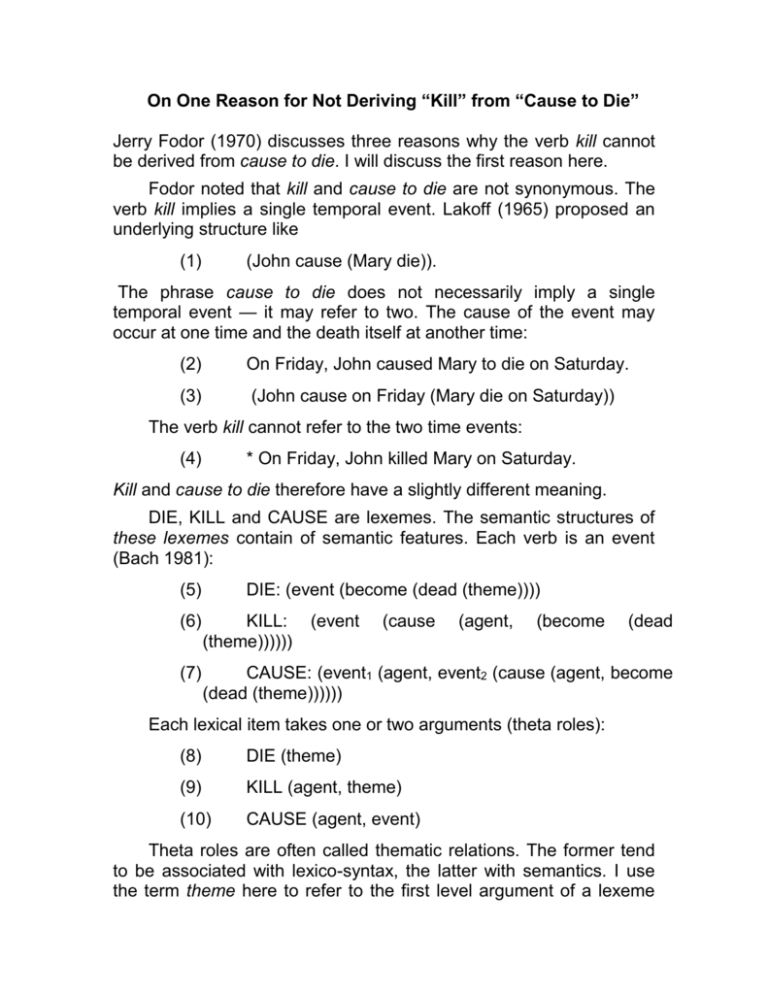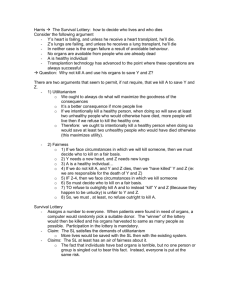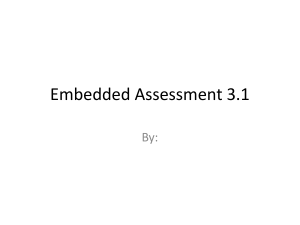On One Reason for Not Deriving Kill from Cause to Die
advertisement

On One Reason for Not Deriving “Kill” from “Cause to Die” Jerry Fodor (1970) discusses three reasons why the verb kill cannot be derived from cause to die. I will discuss the first reason here. Fodor noted that kill and cause to die are not synonymous. The verb kill implies a single temporal event. Lakoff (1965) proposed an underlying structure like (1) (John cause (Mary die)). The phrase cause to die does not necessarily imply a single temporal event — it may refer to two. The cause of the event may occur at one time and the death itself at another time: (2) On Friday, John caused Mary to die on Saturday. (3) (John cause on Friday (Mary die on Saturday)) The verb kill cannot refer to the two time events: (4) * On Friday, John killed Mary on Saturday. Kill and cause to die therefore have a slightly different meaning. DIE, KILL and CAUSE are lexemes. The semantic structures of these lexemes contain of semantic features. Each verb is an event (Bach 1981): (5) DIE: (event (become (dead (theme)))) (6) KILL: (theme)))))) (event (cause (agent, (become (dead (7) CAUSE: (event1 (agent, event2 (cause (agent, become (dead (theme)))))) Each lexical item takes one or two arguments (theta roles): (8) DIE (theme) (9) KILL (agent, theme) (10) CAUSE (agent, event) Theta roles are often called thematic relations. The former tend to be associated with lexico-syntax, the latter with semantics. I use the term theme here to refer to the first level argument of a lexeme and I consider agent to be a secondary argument (DeArmond and Hedberg, 2003). I am assuming here that an event is associated with time at least. CAUSE is itself a temporal event as shown in (5) above and DIE is another temporal event. This accounts for (2), (3) and (4). The structure ‘(not (alive))’ is a state and ‘(become (not (alive)))’ is a change of state. However, neither are events. Thus there is no evidence to support any claim that KILL is derived from a structure that includes (5). The key factor is the lexicon. KILL cannot be derived from (5) because there is no way one can predict which string of semantic structures will form a lexical item. The lexical item KILL goes back to an early Germanic form meaning ‘to strike’. Over time, the semantic structure of a lexeme often changes unpredictably. The lexical item KILL, which includes the semantic structure of ‘die’, does not imply an embedded event. CAUSE does denote an embedded event even though the two events may be perceptually simultaneous, despite the fact that the two events must be logically ordered. If KILL refers to death by a bullet wound, logically the bullet must have affected the patient before the death of the patient. KILL simply does not differentiate between these two semantic events. For these and similar reasons generative semantics failed. Nevertheless, these facts do not support Chomsky’s theories. Bach, Emmon. 1981a. ‘On Time, Tense, and Aspect: An Essay in English Metaphysics.’ In Bach 1981b. Bach, Emmon. 1981b. Ed. Radical Pragmatics. New York: Academic Press Chomsky, Noam. 1995. The Minimalist Program. Cambridge, MIT Press DeArmond, Richard and Nancy Hedberg. 2003. ‘More issues on the argument structure of primary complements.’ In Proceedings of the 2003 Annual Conference of the Canadian Linguistics Association; University of Ottawa: Cahiers Linguistiques d’Ottawa. 50-61 Fodor, Jerry. 1970. ‘Three Reasons for not Deriving “KILL” from “Cause to Die”. Linguistic Inquiry 1.4. Lakoff, George. 1970. Irregularity in Syntax. New York: Holt, Rinehart & Winston.







